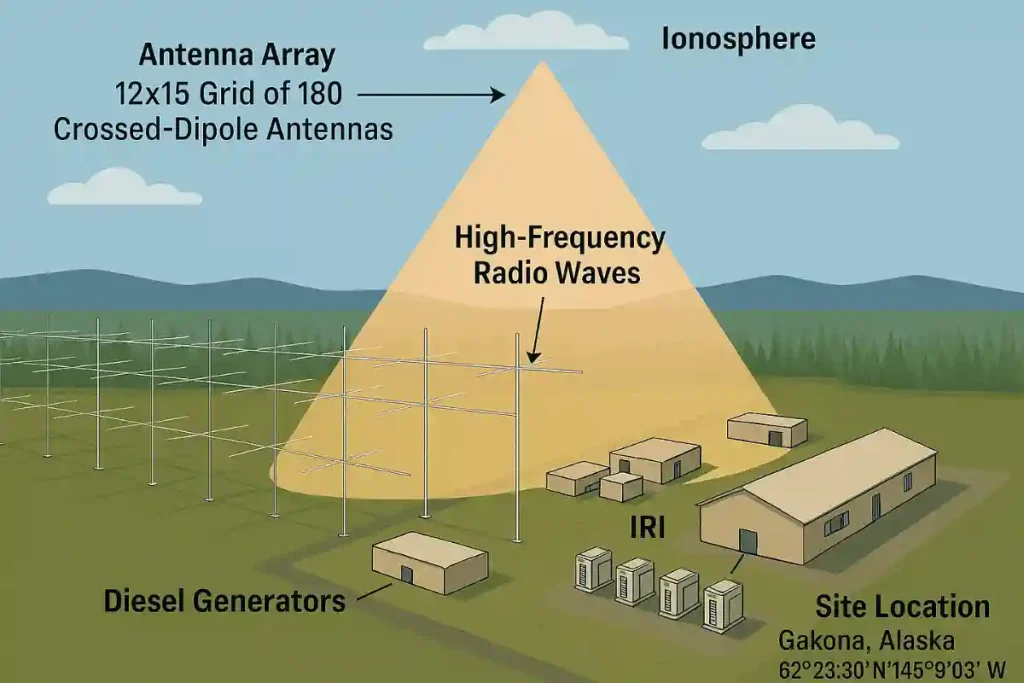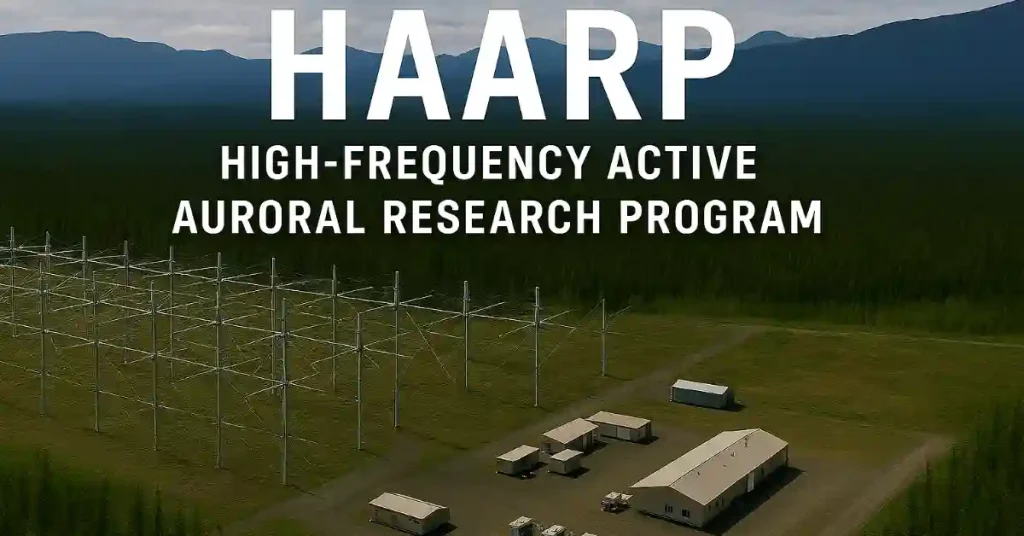The High-Frequency Active Auroral Research Program, commonly known as HAARP Technology, is a scientific research initiative focused on studying the ionosphere—the layer of Earth’s atmosphere extending from about 50 to 400 miles above the surface, where it interfaces with space. Established in the early 1990s, HAARP utilizes high-power radio frequency transmissions to probe and manipulate ionospheric phenomena in controlled experiments.
While its primary goal is to advance understanding of natural atmospheric processes, such as those influenced by solar activity, HAARP has also been linked to potential applications in communications, surveillance, and geophysical exploration. Despite its scientific foundations, HAARP has become a focal point for conspiracy theories, with claims ranging from weather manipulation to earthquake induction. This article provides a comprehensive overview of HAARP’s history, technology, research applications, controversies, and current status as of August 2025.
History of HAARP
HAARP’s origins trace back to 1990, when it was initiated as a congressional project under the influence of U.S. Senator Ted Stevens from Alaska. Construction began in 1993 near Gakona, Alaska, approximately 250 km northeast of Anchorage. The program was initially jointly funded by the U.S. Air Force, U.S. Navy, Defense Advanced Research Projects Agency (DARPA), and the University of Alaska Fairbanks (UAF). BAE Systems Advanced Technologies served as the prime contractor for building the facility.
The development occurred in phases:
- Developmental Prototype (DP): Completed with 18 antenna elements.
- Filled Developmental Prototype (FDP): Expanded to 48 antenna units.
- Final Ionospheric Research Instrument (FIRI): Reached full operational capacity in 2007 with 180 antennas, costing around $250 million in construction and operations by 2008.
In May 2014, the U.S. Air Force announced plans to shut down HAARP due to budget constraints, but following advocacy and negotiations, ownership was transferred to UAF on August 11, 2015, under a cooperative research and development agreement. This shift allowed the facility to continue as a civilian-led research site focused on ionospheric and thermospheric studies. Temporary shutdowns occurred, such as in early 2013 due to contractor changes, but operations resumed under UAF management.
HAARP’s history reflects broader trends in ionospheric research, building on earlier programs like those at the Arecibo Observatory and European facilities such as EISCAT in Norway. By the mid-2010s, it had evolved from a military-funded project to a university-operated observatory, emphasizing collaborative scientific endeavors.
Technology and How It Works

At its core, HAARP is an ionospheric heater—a device that transmits high-frequency (HF) radio waves into the ionosphere to temporarily excite and study a limited area. The centerpiece is the Ionospheric Research Instrument (IRI), a phased array of 180 crossed-dipole antennas spread across 14 hectares.
Each antenna is powered by custom-built transmitters, enabling the system to deliver up to 3.6 megawatts (MW) of power in the 2.8–10 MHz frequency range. The effective radiated power (ERP) can reach up to 5.1 gigawatts, though operations typically run at lower levels for safety and efficiency.
The IRI works by directing a focused electromagnetic beam upward, heating electrons in the ionosphere. This heating alters the ionosphere’s conductivity and density, allowing scientists to observe responses such as plasma instabilities, artificial airglow, or the generation of very low frequency (VLF) and extremely low frequency (ELF) waves. These lower frequencies can penetrate deep into the Earth or ocean, with potential applications in submarine communications.
Supporting instruments include:
- VHF and UHF radars for tracking ionospheric disturbances.
- A fluxgate magnetometer and an induction magnetometer for measuring magnetic field variations.
- A digisonde for ionospheric sounding.
- Optical imagers, spectrometers, and interferometers for visual and spectral analysis.
Power is supplied by five 2,500-kilowatt generators fueled by diesel engines from EMD 20-645-E4 locomotives. HAARP’s technology is akin to other global ionospheric heaters but stands out for its power and flexibility, making it the world’s most capable facility of its kind.
| Key Technical Specifications | Details |
|---|---|
| Antenna Array | 12×15 grid of 180 crossed-dipole antennas |
| Frequency Range | 2.8–10 MHz (HF band) |
| Maximum Power Output | 3.6 MW (transmitted), up to 5.1 GW ERP |
| Operational Modes | Pulsed or continuous wave; linear, O-mode, or X-mode polarization |
| Site Location | Gakona, Alaska (62°23′30″N 145°09′03″W) |
| Power Source | 5 × 2,500 kW diesel generators |
This setup allows for precise, steerable beams that can simulate natural solar-induced phenomena in a controlled environment.
Scientific Research and Applications
HAARP’s primary mission is to enhance knowledge of the ionosphere, which is crucial for radio communications, GPS accuracy, and space weather prediction. By exciting the ionosphere, researchers can study processes like electron acceleration, plasma turbulence, and wave-particle interactions.
Key research areas include:
- Plasma Physics: Observing plasma lines, stimulated electron emissions, and gyro-frequency heating.
- Wave Generation: Producing ELF/VLF waves for long-distance communication and magnetospheric studies, including interactions with the Van Allen radiation belts.
- Atmospheric Phenomena: Investigating artificial airglow, spread F (ionospheric irregularities), polar mesospheric summer echoes (PMSE), and responses to solar flares or geomagnetic storms.
- Geophysical Probing: Using earth-penetrating tomography to detect underground resources like oil, gas, or minerals, or to verify nuclear nonproliferation treaties.
- Extraterrestrial Experiments: Such as the 2008 Lunar Echo experiment, bouncing signals off the Moon.
Collaborations are encouraged, with opportunities for external scientists to deploy instruments like radars or lidars at the site. Militarily, HAARP has refined technologies for over-the-horizon radar, communication disruptions over large areas, and replacing outdated ELF submarine systems. Recent developments, as of 2025, include expanded experiments on ionospheric/thermospheric research, with reports of ongoing tests from 2.8 to 10 MHz through August 15, 2025.
Passive research at HAARP involves satellite beacon monitoring, auroral observations, and ozone layer studies, contributing to broader Arctic research goals.
Controversies and Conspiracy Theories
HAARP’s high-power capabilities have fueled extensive speculation. Conspiracy theories often portray it as a “weather weapon” capable of causing hurricanes, floods, earthquakes, or mind control. For instance, claims linked HAARP to the 2023 Turkey-Syria earthquakes, 2024 Canadian wildfires, and recent events like Hurricane Helene and Milton in the U.S. Other allegations include triggering power outages, downing aircraft (e.g., TWA Flight 800), or causing health issues like Gulf War syndrome.
These theories gained traction through figures like Nick Begich Jr., who suggested HAARP could manipulate weather or act as a giant atmospheric lens, and physicist Bernard Eastlund, whose patents inspired claims of satellite neutralization. Social media amplifies such narratives, with recent X posts attributing global fires, floods, and seismic activity in places like Çanakkale, Turkey, to HAARP operations. Some users reference patents for ionospheric heating to alter jet streams or generate ELF waves for seismic effects.
However, scientific consensus and official statements debunk these claims. HAARP’s energy output is insufficient to influence weather systems, which require vastly more power (e.g., a hurricane involves energy equivalent to thousands of nuclear bombs).
Earthquakes result from tectonic forces, not radio waves, and no evidence supports mind control or disaster induction. UAF and NOAA emphasize that HAARP studies the ionosphere exclusively and cannot manipulate tropospheric weather. Environmental concerns led to hearings by the European Parliament and the Alaska legislature in the 1990s, but no substantiated risks were found.
Despite debunkings, theories persist, often tied to broader distrust of government programs. Incidents like the 2016 arrest of individuals plotting to destroy HAARP (believing it “traps souls”) highlight the extremes.
Current Status and Recent Developments
As of August 2025, HAARP remains operational under UAF management, serving as a hub for ionospheric research. It hosts collaborative projects and supports Arctic studies, with funding details not publicly specified but tied to university and federal grants. Recent experiments include large-scale tests through mid-August 2025, focusing on HF transmissions.
Global analogs exist, such as EISCAT and SuperDARN networks, expanding HAARP-like capabilities worldwide. On X, discussions in 2025 link HAARP to events like Greek wildfires, Turkish earthquakes, and unusual weather patterns, though these remain unsubstantiated. Research continues on ELF/VLF for geophysical applications, but no new military shifts are reported.
Conclusion
HAARP represents a pinnacle of ionospheric research, offering insights into atmospheric science with applications in communication and exploration. While its technology is groundbreaking, misconceptions have overshadowed its contributions.
Balanced examination reveals a tool for discovery, not destruction, underscoring the importance of evidence-based discourse in addressing complex technologies. As research evolves, HAARP’s role in understanding space weather will likely grow, benefiting global scientific communities.
FAQs
What is HAARP and its primary purpose?
HAARP is a research program studying the ionosphere using high-frequency radio waves to heat and excite it. Its main goal is advancing knowledge of atmospheric processes for better communications, GPS accuracy, and space weather forecasting, with applications in plasma physics and geophysical exploration.
How does HAARP technology function?
The core is the Ionospheric Research Instrument (IRI), a 180-antenna array transmitting up to 3.6 MW in the 2.8–10 MHz range. It directs beams to alter ionospheric conductivity, generating waves like ELF/VLF for studies, supported by radars, magnetometers, and optical tools.
What are common conspiracy theories about HAARP?
Theories claim HAARP causes weather disasters, earthquakes, or mind control, linking it to events like hurricanes or wildfires. However, experts debunk these, noting its power is too low to affect tropospheric weather or tectonic forces, focusing solely on ionospheric research.
Who operates HAARP now and its current status?
Since 2015, the University of Alaska Fairbanks manages HAARP as a civilian research site. As of August 2025, it’s operational for ionospheric/thermospheric studies, hosting collaborations and experiments up to 10 MHz, with no military shifts reported.
What are HAARP’s scientific applications?
It probes plasma instabilities, generates waves for submarine communications, studies artificial airglow, and aids in resource detection via tomography. Passive research includes auroral observations and ozone monitoring, contributing to Arctic and space science.





